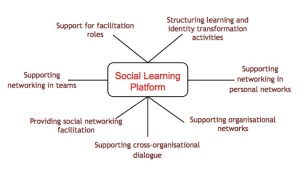MOOCs continue to feature highly at conferences, seminars and events in the Technology Enhanced Learning community and are a subject of some debate and contention. Given the fast moving discussions, this section can only aim to summarise some of the subjects of debate.
There are now hundreds of open online courses available through branded MOOC platforms such as Coursera, Udemy, FutureLearn and Iversity along with self‐hosted courses direct from Universities and even individual lecturers offering open courses outside of their institutions. The vision of the MOOC is exactly that, Massive ‐ anyone can join in, Open ‐ materials available free of charge for all to use and repurpose, Online Course. The extent of the openness of many courses branded as MOOC is questionable, most materials are locked behind logins, passwords and time limits. Some courses come with a fee. As described above, a MOOC is not always a MOOC.
Research by the UK Department for Business Innovation and Skills (BIS) in 2013 highlighted two conflicting strands of thought amongst MOOC professionals.
A strand of enthusiasts welcomes the shake‐up and energy MOOCs bring to learning, teaching and assessment. They report positively on learning experiences and innovative formats of pedagogy, and spotlight themes such as access, empowerment, relationship building and community. This strand is particularly prevalent in the general press. Examples include Shirky and Legon.A strand of sceptics tempers the general enthusiasm along two themes. The supposed benefits of MOOCs were already realised in previous generations of Open and Distance Learning (ODL) innovation – and the innovations of MOOCs are the victory of packaging over content. The MOOC format itself suffers from weaknesses around access, content, quality of learning, accreditation, pedagogy, poor engagement of weaker learners, exclusion of learners without specific networking skills.
The themes emerging from both sides of the argument are those of access and inclusion of learners, quality of content, teaching and learning, networks and communities, and accreditation.
A recent study of MOOCs run by MIT showed that the most typical registrant in the courses were males aged 26 or older with a Bachelor’s degree. However, when the data is viewed in context it is notable that this demographic accounts for less than one in three registrants. Other statistics collected from 17 courses comprising over 600,000 registrants showed that 33% had high school or lower levels of education, 6.3% were over 50, and 2.7% had IP or mailing addresses from countries on the United Nations’ list of least‐developed countries (Rutter, 2014, Ho et.al., 2014, DeBoer et.al., 2014).
The formulaic structure of the branded courses such as Coursera make it easy for a course provider to quickly create an attractive looking sequence of lessons with video, text and assignments. One downside to this method is that there are now hundreds of identical looking courses consisting of video lectures, further reading and the occasional multiple choice quiz. The format has been referred to by critics as “The sage on a stage” and pedagogically reflects the paradigm that teaching is a one‐way process of giving knowledge to another. It is of course possible to use such a platform without being a slave to the formula, but more interaction with students requires more input and more time on the part of the course providers. The issue for the course facilitator is that online courses take time; a survey of professors running MOOCs recently reported that over 100 hours of work occurs before the course has started with a further 8 to 10 hours a week on upkeep (Kolowich, 2013). Factor in that the number of enrolled students on a MOOC can be as high as 160,000 (Rodriguez, 2012) and it becomes evident that dealing with individuals can be an almost impossible task.
Research carried out by MIT into 17 courses on the edX platform suggests that course completion may not be a valid success criteria for online courses or learners. “Course completion rates, often seen as a bellwether for MOOCs, can be misleading and may at times be counterproductive indicators of the impact and potential of open online courses.”
The researchers found evidence of large numbers of registrants who may not have completed a course but still accessed substantial amounts of course content.” (Rutter, 2014)
One of the most contentious debates has been dropout and completion rates. MOOCs in general have a very high dropout rate when compared to conventional courses (both face to face and online). Critics have pointed to this as evidence of the poor quality of courses and the lack of support for learning. Proponents of MOOCs have countered by pointing out how easy it is to sign up for free and open courses and that many learners join only wishing to undertake part of a programme. Openness, they say, is allowing more learners to embark on courses and that conventional measurements of quality such as completion rates are inappropriate for MOOCs.
The openness and availability of the resources will have some impact on the uptake of an online course by students. Participants can be put off by long registration processes or constant requests for login information. It is interesting to note that when materials are easy to access a number of students continue to access, study and participate in online courses beyond the official synchronous running times. Campbell (2014) describes these participants as “archived‐learners”;
“Despite the lack of a defined cohort, deadlines, strong instructor‐ presence, and the ability to earn a Statement of Accomplishment, archived‐learners indicate similar intent and exhibit similarbehavior to live‐learners. And this behavior extends beyond watching videos to completion of assessments and interaction on the discussion forums.” (Campbell, 2014)
The way in which students interact with online course content can be compared to the way in which people interact with other Web‐based media such as video or social network sites. (Rutter, 2014).
Research shows that students tend to navigate a non‐linear pattern through course content with students deemed successful (in that they achieved the certification available for the course) skipping around 20% of the content (Guo & Reinecke, 2014).
BIS (2013) summarises that “Learners who have completed MOOCs emerge from the literature as relatively enthusiastic about the MOOC format. Different kinds of learner experience have been identified, and passive consumption or lurking in a MOOC is a common pattern. The consensus is growing that lurking and auditing have validity as a learning activity within MOOCs, and that non‐completion is not a significant problem in this learning format.”
The early cMoocs were developed using a mixture of Open Source and homegrown software and some providers continue to follow such an approach. The last two years have seen the rapid emergence of MOOC platforms, driven in part by the need to ensure scalability and in part by attempting to standardise and facilitate MOOC design. Most, although not all, of these platforms have been developed by private organisations, often backed by venture capital funding and working in partnership with academic organisations for providing content. There have been some innovations, for instance in allowing designers to annotate video.
There has been some criticism by course developers of the limitations of platforms, particularly the xMooc platforms.
It is likely that more platforms will be released over the next two years and that some will be available as Open Source Software


